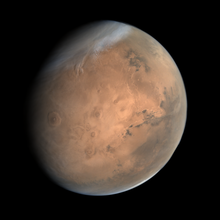Desert planet

A desert planet, also known as a dry planet, an arid planet, or a dune planet, is a type of
arid surface consistency similar to Earth's deserts. Mars is a prominent example of a desert planet in the Solar System.[1]
History
A 2011 study suggested that not only are life-sustaining desert planets possible, but that they might be more common than
A study conducted in 2013 concluded that hot desert planets without runaway greenhouse effect can exist in 0.5 AU around Sun-like stars. In that study, it was concluded that a minimum humidity of 1% is needed to wash off carbon dioxide from the atmosphere, but too much water can act as a greenhouse gas itself. Higher atmospheric pressures increase the range in which the water can remain liquid.[3]
Science fiction
The concept has become a common setting in
Geonosis, and Jakku
.
See also
References
- ^ "Mars". NASA Solar System Exploration. Retrieved 2023-05-01.
- ^ a b c d Choi, Charles Q. (September 2, 2011). "Alien Life More Likely on Dune Planets". Astrobiology Magazine. Archived from the original on 14 July 2014. Retrieved June 12, 2014.
{{cite news}}: CS1 maint: unfit URL (link) - S2CID 27805994.
- ISBN 978-0-8057-7514-3.
- ^ Wright, Les. "Forbidden Planet (1956)". Culturevulture.net (Internet Archive). Archived from the original on May 7, 2006. Retrieved May 7, 2006.
- ^ Hladik, Tamara I. "Classic Sci-Fi Reviews: Dune". SciFi.com. Archived from the original on April 20, 2008. Retrieved April 20, 2008.
- ^ Michaud, Jon (July 12, 2013). "Dune Endures". The New Yorker. Retrieved November 27, 2013.
- ISBN 9780820343679.
- ^ "Star Wars is Dune". D. A. Houdek. Retrieved October 1, 2006.



